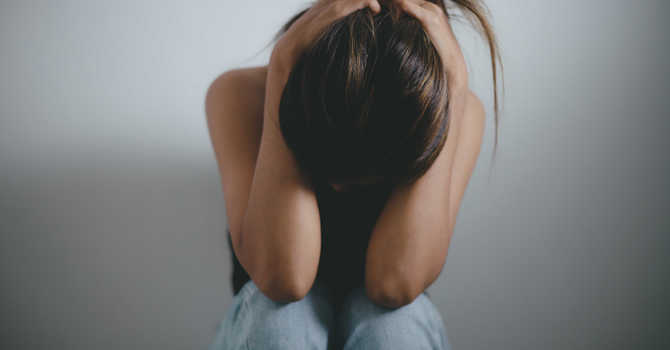
The Mental Health Foundation reported that in December 2020 54% of adults in the UK felt worried or anxious due to Covid-19.[1] This is not surprising because the disruption in normal life, pain and suffering, and uncertainty that the pandemic is causing are taking a toll on many people. If you’re experiencing a high level of anxiety, this overview can help you begin to decrease anxiety and increase emotional stability.
Anxiety is a feeling of apprehension.
Anxiety is an emotion that causes fear and worry as well as physical changes such as high blood pressure.[2] It is a normal response that signals us to address our concerns and protect ourselves from threats.[3] If, for example, your house caught on fire, you would detect danger immediately and run out of it to safety. Upon sensing danger, the brain relays a message to the nervous systems that then releases adrenaline. An increase in adrenaline causes us to feel energetic and alert, gives us a burst of strength, and prepares us to fight (attack), flee (escape), or freeze (hide) as a way to protect ourselves. Increased adrenaline can cause breathlessness, dizziness, shakiness, and tension. These unpleasant side effects are not harmful and usually don’t last long. After the danger passes, our bodies release additional hormones to relax our muscles.[4], [5]
Anxiety has many cognitive, physical, and behavioural effects.
When the flight, flight, or freeze response is activated to protect us from real or perceived dangers, our cognitive, physical, and behavioural systems change.[6]
· Cognitive
Our attention shifts automatically and instantly to the potential danger. The effect on our thinking ranges from slight worry to absolute terror.
· Physical
We may experience multiple physical symptoms including heart palpitations, increased heart rate, lightheadedness, muscle tension, trembling, shallow breathing, and sweating.
· Behavioural
We may adopt certain behaviours (e.g., wearing face masks to decrease exposure to Covid-19) and discontinue others (e.g., avoiding shopping in stores and shopping online instead to prevent close contact with others).
Anxiety is linked to stress and depression.
Anxiety is closely connected to stress and depression. Together these conditions can put an unmanageable strain on those who have problems with them.
Anxiety and stress
Stress is an emotional response to a situation such as a project deadline or chronic illness. It has similar physical and mental symptoms as anxiety including body pain, excessive worry, high blood pressure, loss of sleep, tension, and uneasiness.[7], [8] It usually disappears when the stressor is eliminated. [9] Anxiety is a reaction to stress.[10] It creates a constant feeling of dread that doesn't go away even when there is no immediate danger.[11]
Anxiety and depression
Depression is a mood disorder that causes persistent sadness and loss of interest in life. People with depression may feel worthless, hopeless, and helpless. They may also experience some of the same symptoms that stress and anxiety cause including digestive issues, difficulty concentrating, and sleep problems.[12]
Studies show that anxiety and depression co-occur because similar genetic, environmental, and health factors can cause both conditions.
· Genetic factors
There is often a family history of anxiety and depression that suggests a predisposition to these conditions.
· Environmental factors
Past traumas such as early childhood abuse and current problems including relationship issues, social isolation, and unemployment can cause stress, anxiety, and depression.
· Health factors
Chronic pain—particularly disabling conditions such as fibromyalgia, headaches, irritable bowel syndrome, low back pain, and nerve pain—is closely linked to depression and anxiety. Studies suggest that pain, depression, and anxiety share some of the same biological mechanisms. Anxiety and depression create a vicious cycle because anxiety can produce persistent thoughts about a problem that causes feelings of badness. This shame creates a sense of failure that can lead to depression. The symptoms and poor functioning that depression causes can lead to anxiety.[13]
Anxiety disorders create extreme feelings of apprehension.
Anxiety disorders cause excessive and relentless feelings of apprehension as well as multiple cognitive, physical, and behavioural symptoms.[14] They have several causes: [15]
· Alcohol, illicit drugs, and medications
· Childhood development issues
· Family history of anxiety disorders
· Medical or psychiatric problems
· Traumatic or stressful experiences
Anxiety disorders are a common mental health problem.
Because of the many stressors of living, there are several types of anxiety disorders. Four common types are generalized anxiety disorder, panic disorder, phobias, and post-traumatic stress disorder.[16] Although anxiety disorders have distinct elements, they share three characteristics:[17]
· Irrational and extreme fear
· Tense and apprehensive feelings
· Trouble with managing daily tasks
Generalized anxiety disorder
Generalized anxiety disorder causes people to feel anxious about multiple problems and situations rather than a specific event. Anxiety is experienced most days and sufferers have trouble remembering when they last felt relaxed. As soon as they resolve one anxious thought, another one about a different issue emerges.[18]
Panic disorder
Panic disorder involves regular and sudden attacks of uncontrollable fear that emerge very quickly, usually for no clear reason. Panic attacks cause an onslaught of intense mental and physical symptoms that typically last for 5 to 20 minutes. Although they are frightening and uncomfortable, panic attacks aren’t dangerous.[19]
16 Symptoms of a Panic Attack
· Chest pain
· Chills
· Choking sensation
· Churning stomach
· Dissociation
· Dizziness
· Fear of dying
· Hot flushes
· Nausea
· Racing heartbeat
· Ringing in the ears
· Shaky limbs
· Shortness of breath
· Sweating
· Tingling fingers
· Trembling
Source: National Health Service
Phobias
A phobia is an overpowering and paralysing fear of a feeling, place, or situation or an animal or object. It develops because of an exaggerated sense of danger about the source of the phobia. Phobias are classified as simple/specific or complex.
· Simple/specific phobias
Simple or specific phobias involve a particular activity, animal, object, or situation. They typically start in childhood and may lessen in severity in adulthood. The five most common types of simple/specific phobias are listed below.
- Animal phobias (e.g., dogs, rodents, snakes, and spiders)
- Bodily phobias (e.g., blood, injections, and vomit)
- Environmental phobias (e.g., deep water, germs, and heights)
- Sexual phobias (e.g., performance anxiety)
- Situational phobias (e.g., flying and dentists’ visits)
· Complex phobias
Complex phobias, which are generally more debilitating than simple phobias, stem from a deeply ingrained fear of a certain situation. They typically develop during adulthood. Agoraphobia, claustrophobia, and social phobia are three common complex phobias. Symptoms of phobias may not occur until contact is made with the source of the phobia but just thinking about the source can cause anxiety or panic for some. Very severe phobias can cause people to organise their lives around avoiding the source, which can make it hard to live a normal life. [20]
Social anxiety disorder (social phobia)
Social anxiety disorder is an extreme fear of social situations that usually starts in the teen years. Social anxiety affects daily activities, school, work, relationships, and self-confidence. People with social anxiety disorder become excessively worried before, during, and after social activities. The disorder may become less severe with age but many people still require treatment.[21]
Post-traumatic stress disorder
Post-traumatic stress disorder (PTSD) develops when people have frightening and intensely painful experiences such as brutal personal attacks, major health problems, and serious road accidents. It can develop immediately after the traumatic event or weeks, months, or years later. People who endure traumatic events and situations repeatedly such as severe abuse, neglect, or violence may develop complex PTSD. It has similar symptoms as PTSD and can also develop years after the traumatic experience. It’s typically more distressing than PTSD if the trauma occurred during childhood.[22]
Anxiety’s Impact on Physical Health
Long-term exposure to stress and anxiety can worsen existing physical health problems and increase the risk of developing others including the following:[23]
· Asthma
· Gastrointestinal issues
· Heart attack
· Heart disease
· High blood pressure
· Insomnia
· Stroke
· Type 2 diabetes
· Viral infections
Effective treatment can alleviate anxiety and its symptoms.
There are three standard treatments for anxiety: medication, therapy, and self-management. For some people, these treatments are most effective when undertaken in an appropriate combination.
Medication
Medications such as anti-depressants, benzodiazepines, beta-blockers, and pregabalin can help alleviate severe symptoms of anxiety.[24],[25]
Talking Therapies
Working with a therapist can help you identify unhelpful thought and behavioural patterns, better understand yourself, resolve or find ways to manage complicated feelings, and work on solving problems.[26] Common types of talking therapies are listed below.[27]
· Art and creative
· Behavioural
· Cognitive
· Cognitive-behavioural
· Dialectical behavioural
· Humanistic
· Mindfulness-based
· Person-centred
· Psychoanalytic
· Psychodynamic
· Solution-focused
Self-management
It can be very hard to take care of ourselves with so many responsibilities to meet and problems to deal with but lack of self-care can contribute to anxiety. Daily self-management can help us decrease symptoms of anxiety, become stronger and more capable, and feel better about ourselves. Making lifestyle changes, practising relaxation techniques, and using alternative treatments are three ways to manage anxiety.
Making lifestyle changes
When we’re busy or overwhelmed, we may eat for convenience or comfort and drink beverages that provide a boost of energy. We may also forgo exercise because time is limited or we’re too tired. Making lifestyle changes is often challenging. But incorporating the following changes into your daily routine can help you decrease anxiety and improve overall health.
· Eat a balanced diet that includes fruits, lean meats, vegetables, and healthy fats and avoid processed foods and foods high in sugar.
· Drink at least 6 to 8 glasses of water a day.
· Decrease intake of alcoholic, sugary, and caffeinated beverages. [28]
· Try to get at least 150 minutes of moderate aerobic exercise (e.g., fast walking or cycling) a week and strength exercise at least two days a week.[29]
Practising relaxation techniques
The following activities can help calm the nervous system and alleviate anxiety: [30], [31]
· Bonding with pets
· Fun activities such as hobbies
· Journaling or creative writing
· Mindfulness and meditation
· Relaxation exercises
· Spending time in nature
Using alternative treatments
Alternative treatments such as aromatherapy, cannabidiol (CBD) oil, herbal teas, and herbal supplements may provide relief from anxiety for some people.[32]
It is possible to successfully manage and reduce anxiety.
Covid-19 and related issues including social disruption, unemployment, bereavement, and uncertainty about the future have caused high levels of stress and anxiety in many people. Without intervention, the anxiety that these stressors create could continue and even get worse. If anxiety is hurting your daily functioning, job or academic performance, parenting, or relationships or causing problems in other areas of your life, seeking treatment can help you regain peace of mind and take control of your life. At Life Counsel, we provide a safe and welcoming place for you to talk about what you’re going through and find solutions to your problems.
[1] “Wave 9: Pre-Christmas 2020,” Mental Health Foundation, accessed February 28, 2021, https://www.mentalhealth.org.uk/wave-9-pre-christmas-2020.
[2] “Anxiety,” American Psychological Association, accessed February 25, 2021, https://www.apa.org/topics/anxiety/.
[3] Neil A. Rector, Danielle Bourdeau, Kate Kitchen, and Linda Joseph-Massiah, “Anxiety Disorders: An Information Guide,” Center for Addiction and Mental Health, accessed February 25, 2021, https://www.camh.ca/-/media/files/guides-and-publications/anxiety-guide-en.pdf.
[4] Rector, “Anxiety Disorders.”
[5] “Anxiety and Panic Attacks,” Mind, accessed February 25, 2021, https://www.mind.org.uk/information-support/types-of-mental-health-problems/anxiety-and-panic-attacks/about-anxiety/.
[6] Rector, “Anxiety Disorders.”
[7] “What’s the Difference Between Stress and Anxiety? Knowing the Difference Can Ensure You Get the Help You Need.” American Psychological Association, accessed February 25, 2021, https://www.apa.org/topics/stress/anxiety-difference.
[8] “I’m So Stressed Out! Fact Sheet,” National Institute of Mental Health, accessed February 26, 2021, https://www.nimh.nih.gov/health/publications/so-stressed-out-fact-sheet/index.shtml.
[9] “Anxiety, Depression, Stress: Why the Differences Matter,” Premier Health, accessed February 25, 2021, https://www.premierhealth.com/your-health/articles/women-wisdom-wellness-/anxiety-depression-stress-why-the-differences-matter.
[10] “Stress,” Anxiety & Depression Association of America, accessed February 25, 2021, https://adaa.org/understanding-anxiety/additional-disorders/stress.
[11] “I’m So Stressed Out!”
[12] “What Is Depression?” Web MD, accessed February 25, 2021, https://www.webmd.com/depression/guide/what-is-depression#1-1.
[13] Diana Rodriguez, “How to Cope with Anxiety and Depression: Anxiety and Depression Often Go Hand in Hand,” Everyday Health, accessed February 25, 2021, https://www.everydayhealth.com/anxiety/anxiety-and-depression.aspx.
[14] William C. Shiel Jr., “Medical Definition of Anxiety Disorder,” Medicine Net, accessed February 28, 2021, https://www.medicinenet.com/anxiety_disorder/definition.htm.
[15] Rector, “Anxiety Disorders.”
[16] “Do I Have an Anxiety Disorder?” NHS, accessed February 26, 2021, https://www.nhs.uk/common-health-questions/lifestyle/do-i-have-an-anxiety-disorder/.
[17] Rector, “Anxiety Disorders.”
[18] “Overview - Generalised Anxiety Disorder in Adults,” NHS, accessed February 26, 2021, https://www.nhs.uk/conditions/generalised-anxiety-disorder/.
[19] “Panic Disorder,” NHS, accessed February 26, 2021, https://www.nhs.uk/conditions/panic-disorder/.
[20] “Overview - Phobias,” NHS, accessed February 27, 2021, https://www.nhs.uk/conditions/phobias/.
[21] “Social Anxiety (Social Phobia),” NHS, accessed February 27, 2021, https://www.nhs.uk/conditions/social-anxiety/.
[22] “Overview - Post-traumatic Stress Disorder (PTSD),” NHS, accessed February 27, 2021, https://www.nhs.uk/conditions/post-traumatic-stress-disorder-ptsd/.
[23] Renee Fabian, “9 Ways Anxiety Is Impacting Your Physical Health,” Talk Space, accessed February 27, 2021, https://www.talkspace.com/blog/ways-anxiety-impacts-your-physical-health/.
[24] “Treatment - Generalised Anxiety Disorder in Adults,” NHS, accessed February 28, 2021, https://www.nhs.uk/conditions/generalised-anxiety-disorder/treatment/.
[25] Steph Coelho, “Types of Anxiety Disorder,” Medical News Today, accessed February 28, 2021, https://www.medicalnewstoday.com/articles/types-of-anxiety#treatment.
[26] “Talking Therapy and Counselling,” Mind, accessed February 28, 2021, https://www.mind.org.uk/information-support/drugs-and-treatments/talking-therapy-and-counselling/about-talking-therapies/#WhatAreTalkingTherapies.
[27] “Talking Therapy and Counselling: Types of Talking Therapy,” Mind, accessed February 28, 2021, https://www.mind.org.uk/information-support/drugs-and-treatments/talking-therapy-and-counselling/types-of-talking-therapy/.
[28] “Eating Well to Help Manage Anxiety: Your Questions Answered,” Harvard Health Publishing/Harvard Medical School, accessed February 28, 2021, https://www.health.harvard.edu/blog/eating-well-to-help-manage-anxiety-your-questions-answered-2018031413460.
[29] “Types of Exercise,” NHS Inform, accessed February 28, 2021, https://www.nhsinform.scot/healthy-living/keeping-active/getting-started/types-of-exercise.
[30] Coelho, “Types of Anxiety Disorder: Management.”
[31] Zawn Villines, “How to Treat Anxiety Naturally,” Medical News Today, accessed February 28, 2021, https://www.medicalnewstoday.com/articles/322396.
[32] Villines, “How to Treat Anxiety Naturally.”

Stathi Anthopoulos
Contact Me



